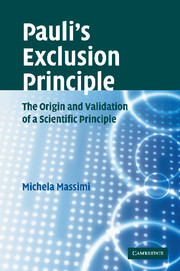Book contents
- Frontmatter
- Contents
- Note on translation
- Preface
- Epigraph
- Introduction
- 1 The exclusion principle: a philosophical overview
- 2 The origins of the exclusion principle: an extremely natural prescriptive rule
- 3 From the old quantum theory to the new quantum theory: reconsidering Kuhn's incommensurability
- 4 How Pauli's rule became the exclusion principle: from Fermi–Dirac statistics to the spin–statistics theorem
- 5 The exclusion principle opens up new avenues: from the eightfold way to quantum chromodynamics
- Conclusion
- References
- Index
2 - The origins of the exclusion principle: an extremely natural prescriptive rule
Published online by Cambridge University Press: 07 August 2009
- Frontmatter
- Contents
- Note on translation
- Preface
- Epigraph
- Introduction
- 1 The exclusion principle: a philosophical overview
- 2 The origins of the exclusion principle: an extremely natural prescriptive rule
- 3 From the old quantum theory to the new quantum theory: reconsidering Kuhn's incommensurability
- 4 How Pauli's rule became the exclusion principle: from Fermi–Dirac statistics to the spin–statistics theorem
- 5 The exclusion principle opens up new avenues: from the eightfold way to quantum chromodynamics
- Conclusion
- References
- Index
Summary
The exclusion principle was the final outcome of Pauli's struggle to understand some spectroscopic anomalies in the early 1920s: doublets were observed in the spectra of alkali metals, singlets and triplets in the spectra of the alkaline earths, and even more anomalous patterns were observed when chemical elements were placed in an external magnetic field (anomalous Zeeman effect and Paschen–Back effect). These anomalous spectra challenged the old quantum theory, and prompted a radical theoretical change (Section 2.1). From 1920 to 1924 Alfred Landé, Werner Heisenberg, and Niels Bohr were all engaged in trying to save the traditional spectroscopic model (the so-called atomic core model) and to reconcile it with the observed anomalies. The impasse was solved only with Pauli's introduction of a fourth degree of freedom for the electron, and the consequent demise of the atomic core model (Section 2.2). What Pauli called the ‘twofoldness’ [Zweideutigkeit] of the electron's angular momentum was soon reinterpreted as the electron's spin (Section 2.3). Pauli's exclusion rule was announced in this semi-classical spectroscopic context that characterized the revolutionary transition from the old quantum theory to the new quantum theory around 1925.
The prehistory of Pauli's exclusion principle
Atomic spectra and the Bohr–Sommerfeld theory of atomic structure
The existence of spectral lines had been known to scientists since the beginning of the nineteenth century when Wollaston and Fraunhofer first observed the dark absorption lines in the spectrum of the Sun.
- Type
- Chapter
- Information
- Pauli's Exclusion PrincipleThe Origin and Validation of a Scientific Principle, pp. 35 - 77Publisher: Cambridge University PressPrint publication year: 2005
- 1
- Cited by



